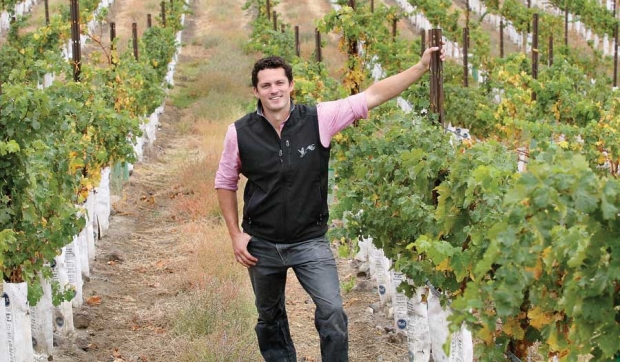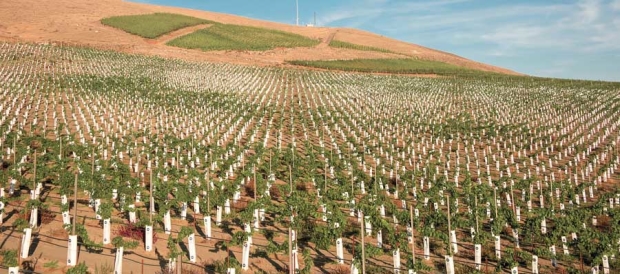
Winemaker Brian Rudin stands in Canvasback’s estate vineyard named Longwinds. The 20-acre block, at 1,100 feet in elevation, is one of the highest vineyards on Red Mountain. (Melissa Hansen/Good Fruit Grower)
While some winemakers might become bored making just one type of wine, Brian Rudin is grateful for the chance to focus on a single varietal.
Rudin, winemaker for Washington’s Canvasback, has a purposeful winemaking mission: craft the best Cabernet Sauvignon wine from the state’s Red Mountain appellation.
Canvasback, owned by California’s Duckhorn Wine Company, is a testament to Washington’s growing wine prominence and national recognition of wine quality.
Canvasback, the sixth winery in the Duckhorn portfolio, is the only Duckhorn winery outside the Golden State.
Canvasback released its first wines from the 2012 vintage and recently planted an estate vineyard on Red Mountain near Benton City.
Good Fruit Grower visited Rudin during the final days of harvest last October to catch him in the throes of crush.
He was busy picking up grapes from Hedges Family Estates’ Jolet Vineyard, destemming grapes on the crush pad, and checking fermentation.
Although he won’t have estate fruit for winemaking until the 2016 harvest, he has access to some of Red Mountain’s best Cabernet Sauvignon growing sites.
Red Mountain AVA (American Viticultural Area) has some of the highest heat units in the state and is known for its bold and impactful fruit. “But within Red Mountain there’s regionality,” Rudin said.
The southeast side tends to produce fruit with intense dark color, huckleberry and blackberry flavors and bright acids, while fruit on southwest facing slopes have more sarsaparilla and spice notes, softer acids and elegant textures.
He also said that the bench below Sunset Road, with its alkaline soils and strong winds, produces powerful, thick-skinned fruit.
Rudin strategically blends a very small percentage — a little more than 5 percent — of Cabernet Sauvignon grapes from Walla Walla Valley AVA to help polish the edges of his wines and accent fruit from Red Mountain.
Sourcing fruit from Walla Walla Valley also helps extend harvest and crush because grapes usually ripen two weeks after Red Mountain.
Because Canvasback wine is labeled as Washington State Red Mountain AVA, 95 percent of the grapes must come from Washington and 85 percent from Red Mountain AVA.
The Canvasback name is in keeping with Duckhorn Wine Company’s waterfowl tradition and joins its other winery names of Paraduxx, Migration, Decoy, Duckhorn Vineyards and Goldeneye.
Canvasback ducks migrate along the Pacific Flyway and have breeding grounds in Washington.
Longwinds Vineyard
Canvasback’s estate vineyard, one of the highest vineyards in elevation on Red Mountain, is aptly named Longwinds.
Rudin said the mountain’s steady breezes provide good, quality airflows that help dry fruit after rain events and minimize disease.
The top of the vineyard is around 1,100 feet elevation, while the lowest point is around 900 feet. The steep slope helps defend against winter injury and provide frost protection.
He noted that not a single vine was lost to the damaging temperatures experienced in November 2014, even though the vineyard had been planted that same year.
Well-known neighbors surround the 20-acre vineyard. Next door is extreme-sloping Force Majeure Vineyards, and nearby are vineyards of Col Solare and Hedges Family Estates.
Varieties planted at Longwinds are Cabernet Sauvignon and Merlot; vineyard spacing is 7 feet between rows, 4 feet between vines. Rows are planted 23 degrees off north, resulting in a northeast-southwest orientation that was chosen for ease of canopy management.
Rudin said that only a minimal amount of leaf cover or “flop” is needed on the west side for sunburn protection compared with the more intensive management and bigger canopies needed for north-south rows.
Vines are being trained to a single and bilateral cordon and vertical-shoot-position trellis system.
Soils at Longwinds Vineyard, classified as Warden series silt loam, are relatively deep at 7 to 10 feet, but they change quickly. At the top of the vineyard on the other side of the access road, soils are fractured basalt and depth is around 2 feet.
Rudin said that having “local boots on the ground” has been very important to Canvasback’s owners in California.
Before Longwinds was planted, Dick Boushey, a grower from Grandview, Washington, and Duckhorn’s viticulture director P.J. Alviso of Napa Valley, collaborated on layout and design. Boushey was responsible for planting and now manages the vineyard.
When Longwinds comes into production in 2016, the estate grapes will complement current vineyard sources used to make Canvasback wines. Rudin sourced fruit from 14 vineyards this past harvest.

Duckhorn Wine Company has put down roots on Washington’s Red Mountain. A recently planted 20-acre estate vineyard will begin bearing fruit in 2016.(Courtesy Duckhorn Wine Company)
“Longwinds is a spectacular spot on Red Mountain, and I envision making great single-vineyard wine,” he said. “But I would never want to give up the great grapes we’ve been sourcing from neighboring vineyards. Canvasback has put together a really strong program the last three years to source some of the very best established vineyards here, and I plan to continue that.”
For now, Canvasback wines are made in the custom crush and winemaking facility of Artifex Winery in Walla Walla.
Artifex, which opened in 2007, has a small client focus, with emphasis on gravity-style handling and small-lot winemaking techniques — the largest tank only holds 8 tons of grapes. Artifex is a full-service, custom-crush facility for small, boutique wineries to medium-sized brands and takes wine from crush to bottle.
Production goals
Rudin hopes to make 15,000 cases from the 2015 vintage, a rapid increase in volume from Canvasback’s initial release of 2,000 cases from the 2012 vintage. When the estate Longwinds Vineyard comes online, annual production could exceed 20,000 cases.
The East Wenatchee native is the founding winemaker for Canvasback. Rudin, with a political science degree, was working in a restaurant to earn money for law school when he changed his career course.
He enrolled in Walla Walla Community College’s enology and viticulture program and was mentored by pioneering viticulturist Stan Clarke.
After graduating from the program in 2007, he worked for Alder Ridge Vineyard and Zefina Winery and then spent six years at Cadaretta Wines of Walla Walla before joining Canvasback.
While at Cadaretta, he was involved in developing a 330-acre site on the north slope of the Walla Walla Valley.
“I’ve been lucky in that every single winemaking job I’ve had has been attached to estate vineyard acres,” Rudin said. “That’s kept me close to the vines and is why I put such an emphasis on the vineyard. My job starts in the vineyard each April, and that’s where I spend most of my time so there are no surprises in September.”
He also is fortunate to have the Duckhorn team of winemakers for support and can call the five other winemakers and winemaking teams for advice.
While each of the six Duckhorn wineries is a separate unit with a different wine focus, Rudin can tap into the depth of experience of his fellow Duckhorn winemakers in California.
“My goal is to figure out the sweet spots on Red Mountain and use the breadth of resources and tools I have to make wine that best expresses Red Mountain,” he said. “I’m very grateful for the ability to focus and drill down on Red Mountain Cabernet. Many other varieties work well on Red Mountain, but what really shines there is Cabernet.” •






Leave A Comment